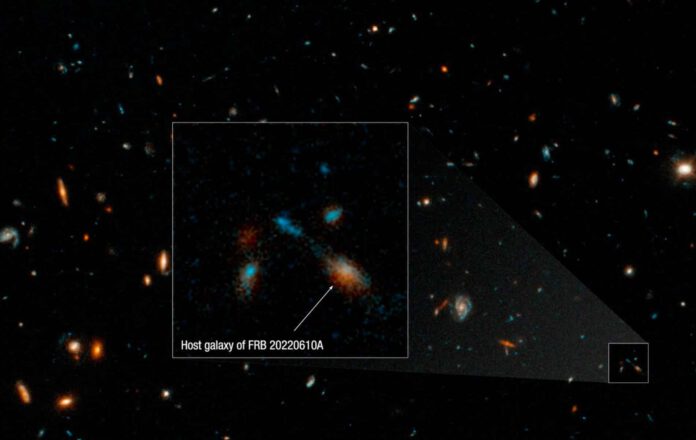
While all preceding Fast Radio Bursts (FRBs) detected up to today have emerged from isolated galaxies, the most distant and powerful radio burst ever recorded by scientists appears to have originated from a collection of no less than seven galaxies.
Hubble Space Telescope Observations
New observations from the Hubble Space Telescope have shed light on this. The findings, based on these observations, were presented at a meeting of the American Astronomical Society in New Orleans.
The FRB 20220610A
The conclusions are centred around a Fast Radio Burst (FRB) detected on June 10, 2022, by a radio telescope in Australia, referred to as FRB 20220610A. This radio burst is special for several reasons. Firstly, it proved to be four times more potent than previously observed fast radio bursts. Additionally, observations from ESO’s (European Southern Observatory) Very Large Telescope indicate that it must have originated at a huge distance from Earth; thus, FRB 20220610A is now recorded as the most distant fast radio burst ever detected.
Determined Origin of FRB
Using the Hubble Space Telescope, researchers have now established where this powerful FRB 20220610A, which had already traversed such a vast distance before scientists spotted it, originated. “It required Hubble’s precision and sensitivity to be able to pinpoint exactly where the fast radio burst came from,” stated researcher Alexa Gordon. “Without Hubble, it would still be a mystery.”
A Cluster of Seven Galaxies
Hubble’s observations reveal that FRB 20220610A originated from a peculiar place. Specifically, a collection of seven galaxies, which existed when the universe was only five billion years old. Being quite unusual, the previous fast radio bursts were always found to emerge from isolated galaxies.
Fusion
These seven galaxies in question seem to be merging, as captured in Hubble’s recordings. Scientists find this intriguing as the sight of seven merging galaxies is rare, and such a situation could contribute to the conditions promoting the occurrence of an FRB. Ultimately, the question that requires an answer is: what causes these fast radio bursts? What precedes them and what is their origin? The Hubble observations give us a splendid view into the surprising types of environments where these mysterious events can occur,” said researcher Wen-fai Fong.
Possibility of a Magnetar
As you could read above, the origin of fast radio bursts is still enshrouded in mystery. However, researchers suspect that a compact object, such as a black hole or neutron star, could be the underlying cause. An extreme type of neutron star is the magnetar. Previously, fast radio bursts in our Milky Way were traced back to such a magnetar, strongly suggesting that these extreme neutron stars have something to do with it.
The revelation that fast radio bursts can also originate from a collection of galaxies not only substantiates this hypothesis, but further strengthens it, explains Fong. “There are indications that some members of this group (galaxies) are interacting with each other. In other words, they may be exchanging material and seem to be merging. This interaction can lead to more star formation,” adds Gordon. “This could suggest that the progenitor of FRB 20220610A could be associated with a fairly recent population of stars, which is consistent with what we’ve learned from other fast radio bursts.”
More Research is Required
Nonetheless, it is still too early for definitive conclusions about the origin of fast radio bursts. More research – and especially more fast radio bursts – will be needed to make that determination. The expectation, however, is that thanks to progressively superior instruments, researchers will continue to discover these bursts in increasing numbers. As more FRBs are found, more will be learned about the environments they emerge from, and whether the environment in which one was detected now is as unique as we currently think. In time, it should also become clearer how exactly these fast radio bursts are manifested. “We need to find more of these fast radio bursts, both nearby and far away and in all sorts of different types of environments,” concludes Gordon.











